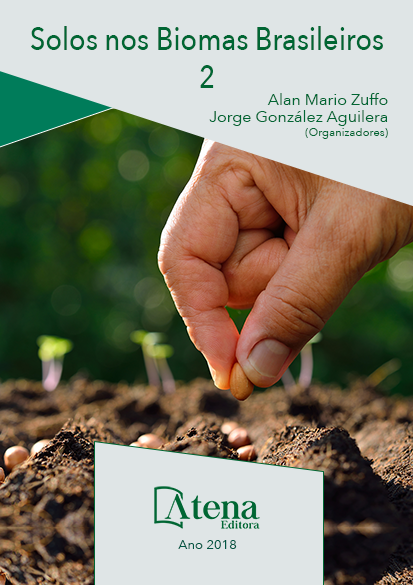
DISPONIBILIDADE DE ÁGUA DO SOLO EM FUNÇÃO DO GRAU DE COMPACTAÇÃO
A compactação do solo modifica
a organização das partículas em uma
conformação mais densa e menos porosa,
alterando a capacidade de armazenamento de
água. Nesse contexto, objetivou-se estudar o
comportamento da disponibilidade de água de
dois solos com texturas distintas submetidos a
variações no grau de compactação. Coletaramse amostras de dois solos com texturas
distintas (Franco arenosa e Muito argilosa). A
caracterização dos mesmos foi feita por meio
de análise do teor de argila, matéria orgânica,
densidade de partículas e curva de compactação
do solo. As curvas de compactação foram
determinadas pelo ensaio de Proctor normal
(560 kPa). Para avaliar o efeito da variação
no grau de compactação (GC), determinou-se
as umidades na capacidade de campo (Ucc)
e no ponto de murcha permanente (Upmp)
para posterior cálculo da água disponível (AD).
Os resultados foram submetidos à análise de
regressão entre a variável GC e as variáveis
Ucc, Upmp e AD. A variação em GC exerceu
influência diretamente proporcional nas
variáveis Ucc e Upmp nos dois tipos de solo,
ou seja, quanto maior GC, maiores foram os
valores de Ucc e Upmp. Para a variável AD,
houve relação inversamente proporcional entre
esta e o grau de compactação apenas para os
solos arenosos (p<0,05 e R2
=0,87), ou seja, a
elevação do grau de compactação conduziu
a uma redução da água disponível. Nos solos argilosos, entretanto, não houve relação entre AD e GC (p>0,05). A compactação
reduz a disponibilidade de água em solos arenosos, entretanto, para solos argilosos,
esse efeito não é significativo.
DISPONIBILIDADE DE ÁGUA DO SOLO EM FUNÇÃO DO GRAU DE COMPACTAÇÃO
-
DOI: 10.22533/at.ed.0941814121
-
Palavras-chave: capacidade de campo; ponto de murcha permanente; textura do solo; Proctor normal; densidade máxima
-
Keywords: field capacity; permanent wilting point; soil texture; Proctor normal; maximum density
-
Abstract:
Soil compaction modifies the organization of the particles in an dense, less
porous conformation, altering the water storage capacity. In this context, the objective
was to study the behavior of water availability of two soils with different textures submitted
to variations in the degree of compaction. Samples were collected from two soils with
distinct textures (Sandy loam and Very clayey). Their characterization was done through
analysis of the clay content, organic matter, particle density and compaction curve. The
compaction curves were determined by the normal Proctor assay (560 kPa). In order to
evaluate the effect of the variation in the degree of compaction (GC), it was determined
the moisture in the field capacity (Ucc) and in the permanent wilting point (Upmp) for
calculation of available water (AD). The results were submitted to regression analysis
between the variable GC and the variables Ucc, Upmp and AD. The variation in GC
exercised directly proportional influence on the Ucc and Upmp variables in the two
soil types, that is, the higher the GC, the higher the Ucc and the Upmp values. For the
variable AD, there was inversely proportional relation between this and the degree of
compaction only for the sandy soils (p<0.05 and R2=0.87), that is, the elevation of the
degree of compaction led to a reduction of water available. In the clay soils, however,
there was no relationship between AD and GC (p>0.05). Compaction reduces the
availability of water in sandy soils, however, for clay soils, this effect is not significant
-
Número de páginas: 15
- Fernanda Paula Sousa Fernandes


